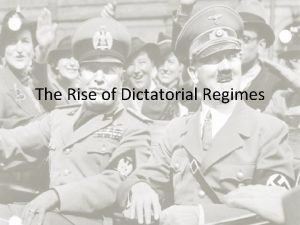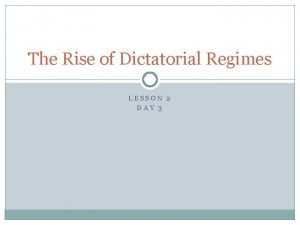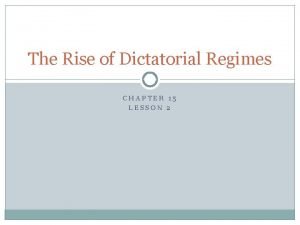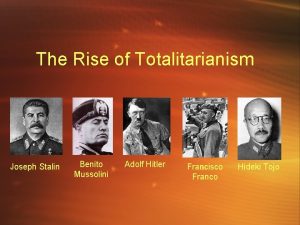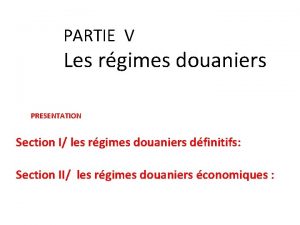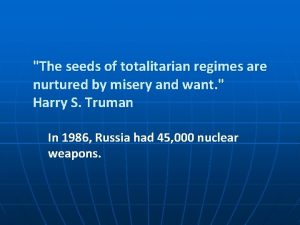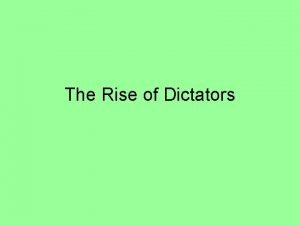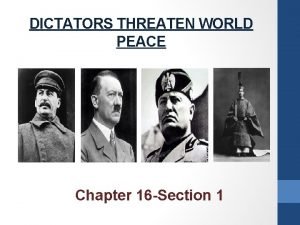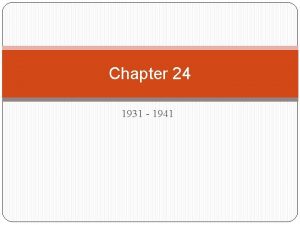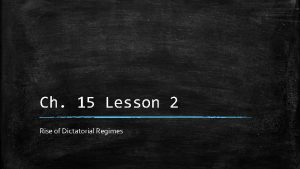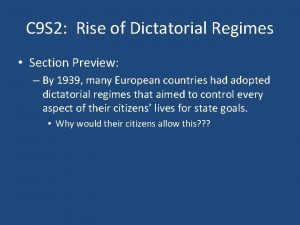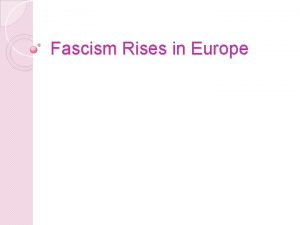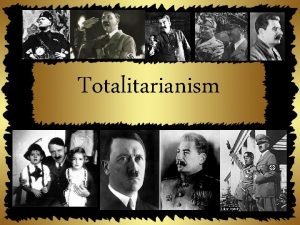Rise of Dictatorial Regimes Dictators Fascism Authoritarianism INTRODUCTION














- Slides: 14

Rise of Dictatorial Regimes { Dictators, Fascism & Authoritarianism

INTRODUCTION “Anti-individualistic, the Fascist conception of life stresses the importance of the State and accepts the individual only in so far as his interest coincide with those of the State…The Fascists conception of the State is all-embracing outside of it no human or spiritual values can exist. Thus understood, fascism is totalitarian, and the Fascist State…interprets, develops, and potentiates [makes effective] the whole life of a people…fascism does not, generally speaking, believe in the possibility or utility of perpetual peace…War alone keys up all human energies to their maximum tension and sets the seal of nobility on those people who have the courage to face it. ”

Dictators The apparent triumph of democracy in Europe after World War I, was extremely short-lived – by 1939, only France and Great Britain remained democratic A new form of dictatorship was the modern TOTALITARIAN STATE – a government that aims to control the political, economic, social, intellectual and cultural loves of its citizens Wanted to conquer the minds and hearts of their subjects and went about doing so through mass propaganda techniques and high-speed modern communication Totalitarian states that emerged: Led by a single leader and single party Rejected the idea of limited government power and the guarantee of individual freedoms Individual freedom was subordinated to the collective will of the masses…and the collective will of the masses was dictated by the leader Totalitarian state expected the active involvement of the masses in the achievement of its goals, whether those goals included war, a socialist state or a thousand-year


Fascism FASCISM – political philosophy that glorifies the state above the individual by emphasizing the need for loyalty and obedience to its leader Most fascists shared several ideas: Preached an extreme form of nationalism Believed that nations must struggle – peaceful states were doomed to be conquered Loyalty to a totalitarian leader In each nation, fascist wore uniforms of certain color, used special salutes and held mass rallies

{ SIMILARITIES BOTH systems were ruled by dictators who allowed only their own political party BOTH denied individual rights { DIFFERENCES FASCISTS did NOT seek a classless society Fascism vs. Communism… Believed that each class had its place and function FASCISTS were nationalists whereas COMMUNISTS were internationalists (hoping to unite workers worldwide)


Fascism in Italy Like other European countries, Italy experienced severe economic problems after World War I Inflation grew, both industrial and agricultural workers staged strikes Socialists spoke of revolution and many in the middle class began to fear a Communist takeover like that one that had occurred in Russia Industrial and agricultural strikes created even more division Benito Mussolini Newspaper editor and politician Boldly promised to rescue Italy by reviving its economy and rebuilding its armed forces 1919, Mussolini founded the Fascist Party As economic conditions worsened, his popularity increased Publicly criticized Italy’s government

Fascism in Italy 1920 -1921, Mussolini formed bands of black-shirted, armed Fascists called squadristi (Blackshirts) Blackshirts attacked socialist offices and newspapers as well as in the streets – Mussolini played on the fear of a worker’s revolt and began to win support from the middle classes, aristocracy and industrial workers By 1922, Mussolini’s movement was growing quickly Mussolini realized that the Italian people were angry over Italy’s failure to receive more land in the peace settlement following

Fascism in Italy October 1922, about 30, 000 Fascists marched on Rome demanding that King Victor Emmanuel III put Mussolini in charge of the government The King decided that Mussolini was the best hope for his dynasty to survive and after widespread violence, he gave in and made him prime minister By 1922, Mussolini’s movement was growing quickly Il Duce’s leadership New laws gave the government the right to suspend any publications that criticized the Catholic Church, the monarchy or the state Government censors forced radio stations and publications to broadcast/publish only Fascist doctrines

Fascism in Italy Despite all of his efforts, Mussolini never achieved the degree of totalitarian control as seen in Germany under Adolf Hitler or the Soviet Union under Joseph Stalin Fascist Party did not completely destroy Italy’s old power structure Some institutions (such as the armed forces) managed to keep most of their independence King Victor Emmanuel III remained in power Mussolini's regime recognized the sovereign independence of Vatican City where the Catholic Church was headed Mussolini’s regime gave the Church a large

Authoritarianism in Spain In Spain, political democracy failed to survive General Francisco Franco led Spanish military forces in a revolt against the democratic government in 1936, and a brutal and bloody civil war broke out Fascist regimes of Italy and Germany aided Franco’s forces with arms, money and men Hitler used the Spanish Civil War as an opportunity to test the new weapons of his revived air force Spanish republican government was aided by 40, 000 foreign volunteers and by trucks, planes, tanks and military advisors from the Soviet Union Spanish Civil War came to an end when Franco’s forces captured Madrid in 1939 and Franco established a dictatorship that favored large landowners, businesspeople, and the Catholic clergy *Due to the fact that it favored traditional groups and did not try to control every aspect

Authoritarianism in Eastern Europe The nations formed in Eastern Europe after World War I adopted some of the features of totalitarian states; however, the main concern of these authoritarian governments was not to create a new kind of mass society, but rather to preserve the existing social order Hungary, 1919, after a brief Communist regime, military forces and wealthy landowners joined to make Admiral Miklós Horthy the first European postwar dictator Poland, 1926, Marshal Jozef Pilsudski seized power In Yugoslavia, Albania, Bulgaria, and Romania, kings turned to strong-man rule suspending constitutions and silenced foes Why did parliamentary systems fail in most eastern European states? States had little tradition of political democracy Mostly rural and agrarian – most of the peasants were illiterate and much of the lands was still dominated by large landowners who feared the peasants Powerful landowners, the churches, and even some members of the middle class

 The rise of dictatorial regimes
The rise of dictatorial regimes The rise of dictatorial regimes lesson 2
The rise of dictatorial regimes lesson 2 Lesson 2 the rise of dictatorial regimes
Lesson 2 the rise of dictatorial regimes Rise of dictators graphic organizer
Rise of dictators graphic organizer Totalitarian vs authoritarian
Totalitarian vs authoritarian Rise and rise until lambs become lions
Rise and rise until lambs become lions Richard nixon tricky dicky
Richard nixon tricky dicky Raise and rise again until lambs become lions
Raise and rise again until lambs become lions A union b example
A union b example Régimes douaniers
Régimes douaniers The seeds of totalitarian regimes are nurtured
The seeds of totalitarian regimes are nurtured Types of dictatorship
Types of dictatorship Chapter 16 dictators threaten world peace
Chapter 16 dictators threaten world peace Chapter 24 world war looms
Chapter 24 world war looms Chapter 24 section 1 dictators threaten world peace
Chapter 24 section 1 dictators threaten world peace
